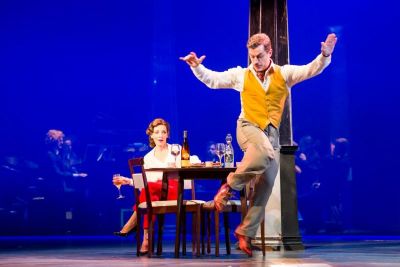Ladies in Black
QTC’s first original musical in 16 years, Ladies in Black, is appealing in its evocation of an era (the late 50s), but lacks emotional conflict to make it really engaging. Not an easy book to adapt, most of what is in the pages of Madeleine St John’s wisp of a novel is on stage in Carolyn Burns’ episodic adaptation of it which has been stylishly staged by Simon Phillips using revolves.
The protagonist, 17-year old Lesley, a would-be poet, gets a seasonal job at F.G. Goode’s Sydney department store (think David Jones), changes her first name to Lisa, and becomes embroiled in the haute couture world of fashion and the lives of her co-workers. It’s a coming-of-age story as well as an ugly-duckling-into-swan scenario when the character loses her bookish glasses, sweeps up her hair, and suddenly becomes a young woman at the end of the first act. In the role, newcomer Sarah Morrison projects innocence and wonder and has a soaring soprano to boot.
 The strength of the novel and of the musical is the back stories of the shop assistants Patty and Fay. Played by Lucy Maunder and Naomi Price, they bring massive musical theatre savvy to their roles. Maunder finds heart and sympathy in Patty, a woman who is struggling with the fact her husband walked out on her after ten years of marriage because he could be impotent, and Price is a comic gem as Fay who has been searching for Mr Right and finally finds him in a ‘continental.’ Leading the company she makes “I Kissed a Continental” into a showstopper.
The strength of the novel and of the musical is the back stories of the shop assistants Patty and Fay. Played by Lucy Maunder and Naomi Price, they bring massive musical theatre savvy to their roles. Maunder finds heart and sympathy in Patty, a woman who is struggling with the fact her husband walked out on her after ten years of marriage because he could be impotent, and Price is a comic gem as Fay who has been searching for Mr Right and finally finds him in a ‘continental.’ Leading the company she makes “I Kissed a Continental” into a showstopper.
Magda, the Slovenian head of “Model Gowns” adds piquancy to the mix and couldn’t be in better hands than those of Christen O’Leary. The male characters are all basically ciphers in this story which is female centric, but Greg Stone lends authority to Lisa’s father, who spouts clichéd attitudes of the time believing women don’t need higher education.
Tim Finn’s first score for the musical theatre is a mixed bag. He gets it right with a great opening number in “I Got it at Goode’s”, and a boisterous and funny “He’s a Bastard”, but the second act, with the exception of “Continental”, has far too many song fragments that don’t come together as a cohesive whole.
Gabriela Tylesova’s set, with its opaque glass columns, reeks of department store gloss and her costumes, which mirror Chanel, Ames and Laurent, time and time again bring class to the stage. Andrew Hallsworth’s choreography is good and punchy, David Waters’ lighting hits its mark, and Isaac Hayward conducts a tight chamber orchestra that when needed delivers a loud thumping bass.
Peter Pinne
Photographer: Joseph Byford.
Subscribe to our E-Newsletter, buy our latest print edition or find a Performing Arts book at Book Nook.

